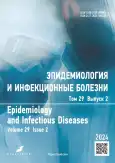Clinical cases of legionelliosis in the Krasnodar region during the new coronavirus infection COVID-19 pandemic: difficulties in diagnosis
- Authors: Avdeeva M.G.1, Blazhnyaya L.P.1, Moshkova D.Y.1, Kulbuzheva M.I.1,2, Savitskaya I.M.2, Podsadnyaya A.A.1,2, Kirilenko N.A.1,2, Yakovchuk E.E.2, Chernyavskaya O.V.2, Mamonova P.O.2
-
Affiliations:
- Kuban State Medical University
- Specialized Clinical Infectious Diseases Hospital
- Issue: Vol 29, No 2 (2024)
- Pages: 151-164
- Section: CASE REPORTS
- URL: https://journals.rcsi.science/1560-9529/article/view/257365
- DOI: https://doi.org/10.17816/EID627123
- ID: 257365
Cite item
Abstract
The high incidence of community-acquired pneumonia during the COVID-19 pandemic requires early differential diagnosis because of the differences in patient management techniques. Among community-acquired pneumonias, legionelliosis deserves special attention. The difficulty of clinical diagnosis of legionellosis during the COVID-19 pandemic leads to untimely prescription of specific antibacterial therapy, which worsens the prognosis. This study presents clinical examples that draw the attention of specialists to the clinical, laboratory, and radiological features of legionellosis and to the important role of epidemiological data in the differential diagnosis of legionellosis with COVID-19.
A feature of the described clinical cases was as follows: late diagnosis with hospitalization on days 7–10 of illness in patients with increased body mass index, severe bilateral polysegmental pneumonia with the formation of a cavity and multirow bullae in the lungs, presence of proteinuria, increased levels of urea and/or creatinine, and lymphopenia. In all cases, the patients had history of staying in air-conditioned rooms and traveling by train. Compute tomography diagnostics described a localization that is not typical for COVID-19, manifestation from areas of consolidation with a symptom of air bronchography, presence of pleural effusion, discrepancy between the intensity of changes from the disease onset, and severity of the patient’s condition.
For the specific diagnosis of legionellosis, testing for Legionella spp. To determine the legionella antigen in the urine is recommended upon hospital admission for all patients with severe community-acquired pneumonia.
Keywords
Full Text
##article.viewOnOriginalSite##About the authors
Marina G. Avdeeva
Kuban State Medical University
Author for correspondence.
Email: avdeevam@mail.ru
ORCID iD: 0000-0002-4979-8768
SPIN-code: 2066-2690
MD, Dr. Sci. (Medicine), Professor
Russian Federation, KrasnodarLyudmila P. Blazhnyaya
Kuban State Medical University
Email: p-blazhnyaya@mail.ru
ORCID iD: 0000-0002-0055-1764
SPIN-code: 1164-7038
MD, Cand. Sci. (Medicine), Associate Professor
Russian Federation, KrasnodarDarya Yu. Moshkova
Kuban State Medical University
Email: Mrs_darya@mail.ru
ORCID iD: 0000-0003-1401-6970
SPIN-code: 9489-0057
MD, Cand. Sci. (Medicine), Associate Professor
Russian Federation, KrasnodarMakka I. Kulbuzheva
Kuban State Medical University; Specialized Clinical Infectious Diseases Hospital
Email: kulbuzhevamakka@yandex.ru
ORCID iD: 0000-0003-1817-6664
SPIN-code: 8090-3715
MD, Cand. Sci. (Medicine), Associate Professor
Russian Federation, Krasnodar; KrasnodarIlina M. Savitskaya
Specialized Clinical Infectious Diseases Hospital
Email: avdeevam@mail.ru
ORCID iD: 0009-0004-5818-5287
Russian Federation, Krasnodar
Angelina A. Podsadnyaya
Kuban State Medical University; Specialized Clinical Infectious Diseases Hospital
Email: avdeevam@mail.ru
ORCID iD: 0009-0009-5225-9296
SPIN-code: 8490-1523
Russian Federation, Krasnodar; Krasnodar
Natalya A. Kirilenko
Kuban State Medical University; Specialized Clinical Infectious Diseases Hospital
Email: nafany-78@mail.ru
ORCID iD: 0000-0003-2302-6214
Russian Federation, Krasnodar; Krasnodar
Elena E. Yakovchuk
Specialized Clinical Infectious Diseases Hospital
Email: elena-yakovchuk@yandex.ru
ORCID iD: 0009-0001-9690-7285
Russian Federation, Krasnodar
Oksana V. Chernyavskaya
Specialized Clinical Infectious Diseases Hospital
Email: kdlskib@mail.ru
ORCID iD: 0009-0007-8032-3537
Russian Federation, Krasnodar
Polina O. Mamonova
Specialized Clinical Infectious Diseases Hospital
Email: polinadoncova@yandex.ru
ORCID iD: 0009-0002-6945-7263
Russian Federation, Krasnodar
References
- Cattan S, Thizy G, Michon A, et al. Actualités sur les infections à Legionella. Rev Med Interne. 2019;40(12):791–798. (In French). doi: 10.1016/j.revmed.2019.08.007
- Graham FF, Hales S, White PS, Baker MG. Review Global seroprevalence of legionellosis — a systematic review and meta-analysis. Sci Rep. 2020;10(1):7337. doi: 10.1038/s41598-020-63740-y
- Chauhan D, Shames SR. Pathogenicity and Virulence of Legionella: Intracellular replication and host response. Virulence. 2021;12(1):1122–1144. doi: 10.1080/21505594.2021.1903199
- Kim S, Isberg RR. The Sde phosphoribosyl-linked ubiquitin transferases protect the Legionella pneumophila vacuole from degradation by the host. Proc Natl Acad Sci U S A. 2023; 120(33):e2303942120. doi: 10.1073/pnas.2303942120
- Shames SR. Eat or Be Eaten: Strategies Used by Legionella to Acquire Host-Derived Nutrients and Evade Lysosomal Degradation. Infect Immun. 2023;91(4):e0044122. doi: 10.1128/iai.00441-22
- Böck D, Hüsler D, Steiner B, Medeiros JM, Welin A, Radomska KA, Hardt WD, Pilhofer M, Hilbi H. The Polar Legionella Icm/Dot T4SS Establishes Distinct Contact Sites with the Pathogen Vacuole Membrane. mBio. 2021;12(5):e0218021. doi: 10.1128/mbio.02180-21
- Tomaskovic I, Gonzalez A, Dikic I. Ubiquitin and Legionella: From bench to bedside. Semin Cell Dev Biol. 2022;132:230–241. doi: 10.1016/j.semcdb.2022.02.008
- Park B, Park G, Kim J, Lim SA, Lee KM. Innate immunity against Legionella pneumophila during pulmonary infections in mice. Arch Pharm Res. 2017;40(2):131–145. doi: 10.1007/s12272-016-0859-9
- Chahin A, Opal SM. Severe Pneumonia Caused by Legionella pneumophila: Differential Diagnosis and Therapeutic Considerations. Infect Dis Clin North Am. 2017;31(1):111–121. doi: 10.1016/j.idc.2016.10.009
- Viasus D, Gaia V, Manzur-Barbur C, Carratalà J. Legionnaires’ Disease: Update on Diagnosis and Treatment. Infect Dis Ther. 2022;11(3):973–986. doi: 10.1007/s40121-022-00635-7
Supplementary files















